A report on Management of Change in Adoption of New Business structure by Spotlight
INTRODUCTION.
Changes in the organizational operating environment makes a critical effect on how they behave, perform and thrive. Change forces the organization to adapt to new form of operation, structure, management, objectives, goals, workforce policies and competitors (McGreevy, 2003). The effect of adopting new structure, policies, culture and occasionally management in an organization is much of psychological attitude and behavior of the employee in adopting new environment and system, which can be a crucial aspect in psychology dissertation help.
The initiative of installing new technology, downsizing, restructuring, trying to change corporate culture, have had low success with 70 percent of them failing. Most fail is not in the rust to change rather it’s the managers’ management of change leaders to failure. It is imperative for leaders to understand precisely the nature and process of corporate change prior to adoption of any change (Beer and Nohria, 2000)
Aims.
To provide an effective and efficient ways to adopt change by the Spotlight PR Ltd, by adopting a system that works profoundly well and effectively in advancement of business in new environment. Also, the report intend to offer an insightful means and theory that helps to understand the concept and challenges incurred during transition period.

Concept of Change.
Change has context such as causes, constraints, process of change and opportunities which are inner and outer concepts of the organization, (Beer and Swailes, 2010). Organizational change occurs when transitioning from one form to another, for instances the development of internet-based business has changed the form of conducting business and business priorities in regard to corporate reputation (Myers et al. 2012). Therefore, in this case, the need for new strategy forming a new organization with different structures, culture and policies, is forcibly unavoidable and fundamentally clear for a business survival.
Change management report, Spotlight PR Ltd.
Background study.
Organization culture.
Culture as defined by Mavondo and Farrell (2003) is broad tacitly understood rules and procedures that inform the organizational member on what, and how, to do under a given undefined situations though listed by some as a property of the company, can be managed, manipulated and observed (Smith, 2003). As argued by Bryan (2008), the concept of culture, dominant, emergent and residual, is a useful and accessible framework for analysis and reflection on the organizations, and its constant change has much to offer in understanding the organization structure, management, believes, post-industrial and individualist context. Although culture provides an effective ways of communication and coordination, and subsequently save working time (Mavondo, 2003), a lot of care should be take particular during transition as two different cultures, previous and new are incorporated in the new company.
How to change a culture.
Shook proposed that the only way to change culture is to change the observable data of an organization, this includes what people do and how they behave. Therefore, the Spotlight PR Ltd need to define the actions and behaviors they desire prior to the adoption of new policies then design the action workout that are necessary in reinforcing those attributes “It’s easier to act your way to a new way of thinking than to think your way to a new way of acting” (Shook, 2010).
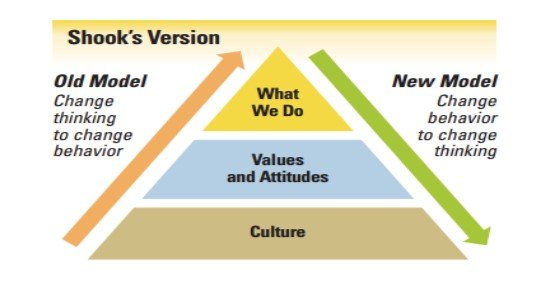
Diagram 1. Shook’s model of change. (Shook, 2010).
Change management report, Spotlight PR Ltd.
This model of change raise the question; ‘how the behavior of the Spotlight PR Ltd can be changed to conform to the new system?’ to answer the question, a number of steps have to be taken. First, enhances the culture and commitment of workers to work in a way that builds the quality by working together. Secondly, as management, have obligation of providing the means and trust for employees, to solve problems encountered (Hayes, 2002).
Decline in morale are inevitable during change, talent and skilled workforce are in danger of being lost (McGreevy, 2010). Workers commitment to the organization may reduce if they feel the company is unfair, non-committed or untrustworthy during reorganization. Its critical for an organization to adopt an effective transition strategy otherwise the employees will feel outsiders and exhibit negative behaviors which will affects the organizations operations in long term (Smith 2003). Managing uncertainty by organization eradicates the necessity of employee to balance opportunities against insecurities during transition. Although, the significance of work will not change for an individual irrespective of the insecurity it implies, the individual behavior and attitudes need to be managed during this period (McGreevy, 2010)
The organization should change the employee’s notion of repetitive output and rather recognize the need to constantly reinvent themselves in order to demonstrate and add value to the organization (Phelps et al. 2007).
Implementing change.
Change is inevitable, new initiatives, project-based working, staying ahead of competition, technology improvement to mention a few are forms of changes experiences in daily business life. Delivering and implementing the new ways of operation is fundamental in any new structure or company. Kotter (1979), a leadership and change management guru, demonstrated an eight steps process in Kotter’s 8-step change Model that have in step-wise progressive means of adopting the changes in an organization. It is fundamentally important to adopt this steps to the point in order to avoid failure in future organization.
Change management report, Spotlight PR Ltd.
Kotter’s 8-step Model.
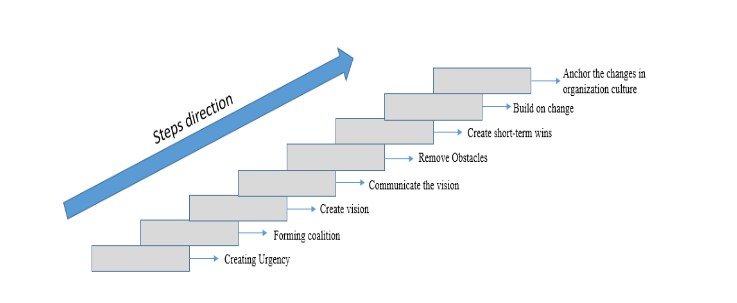
Diagram 3. Kotter change Model.
Step 1: Create Urgency.
For a real change to happen that will result in successful business takeover, a sense of urgency needs to be developed around the change to be implement, that is changing from management and promotions to corporate reputation management via internet (Kotter, 1979). This is a form of sparking the initial motivation to get things going and ‘buying into’ the change. This is achieved by opening an honest discussion and involvement with employees about the change, it is not a matter of showing employees and shareholders a mere statistics or talking about the change in the industry but what happening in the marketplace and competitors. Identify potential threats to be expected, creating scenarios examining opportunities to be exploited and forging support for outside stakeholders, customers and employees is a paramount in embracing change (Burnes, 2009). This step should be taken with caution, proper preparation and not to be rushed or panic
Step 2: Form a powerful coalition.
All member of the organization regardless of status and post need to be fully on board of the changes expected. The leaders need to leader the change rather than manage it. For effective implementation of change, strong team, influential people and collision from different field of expertise, job title and political in the institution has to brought together (Greiner, 1972). This is
Change management report, Spotlight PR Ltd.
done by identifying the true leaders in organization and also in key stakeholders and asking for commitment for them. The teams has to be check for weakness and ensuring a mix of people before change.
Step 3: Create a vision and strategy of change.
A clear vision that people can easily gasp and follow is needed. When individuals see what is required of them, directives given to them tend to be simple and more sensible (Phelps, 2007). State explicitly the reason for the change and its benefits, and the future of the company, a good vision demands sacrifice for betterment of the organization shareholders. A strategy of transition must be there, such question as; the position of the organization at the moment, what it needs or rather future plans and how it will reach there, also the required knowledge, skills resources are fundamentally important at this stage.
Step 4: Communicate the vision.
The vision of the organization to adopt the changing market for the business has to be communicated effectively, frequently and timely to all involved parties (Hayes, 2002). This can be through writing, reporting, motivation, meetings, training or direct engagement with employees, management and shareholders. The organization need to demonstrate the kind of attitude and embrace towards to changes, “walking the talk” instead of just say (Burnes, 2004). Also all the concerns from the parties involved should be addressed honestly and openly.
Step 5: Remove Obstacles.
People do not adopt change easily, some will resist, reluctant or have negativity. Continuously checking and removing barriers that gets in the way, and develop structures that eliminates them is necessary (Beer and Nohria, 2000). A team or leaders to oversee the transition can be hired with main role is to deliver the change, recognize the people for the abilities and efforts in enabling the smooth transition (Paton and McCalman, 2008). Assure the reorganization plans of the company and employee such as providing assurance of the job security, empowering and coaching the right individuals, also identifying and helping individuals who are against the change is necessary at this stage.
Step 6: Create short-term wins.
Creating a taste of success is a great motivating factor. A short combined sale by the ‘new company’ can demonstrate the end results after the change, this will silences the negative thinkers and critics (Schwartz and Shulman, 2007). Generally boosting morale among the
Change management report, Spotlight PR Ltd.
employees and other stakeholders. This can be a week or two demonstration, it should be justifiable and thoroughly analyzed and thought through as failure can really hurt the project entirely (Burnes, 2009).
Step 7: Build on the change.
Professing success too early can lead to ultimate fall of the new company (Kotter, 1979). Real and long lasting change runs deep and have full understanding of the system. During transition and first implementation phase, success and failures should be analyzed for continuous improvement and maintain the success momentum. The plans of how to avoid the risk of premature success and its implications on the organization particular after the successful short wins, how to build around them.
8: Institutionalize change.
Finally, for the change to be permanent, it should be part of the new organization core principles. Make continuous efforts to ensure the change is supported and seen by all the employees and stakeholders, and integrating gradually into organization culture (Smith, 2003). The structure and policies should be easy available and accessible for instance having new changes on the posters and company leaflets, moreover ensuring they are in marketing and advertising and company brochures. Organization culture determines what and how somethings are done, so the values behind the company vision must be displayed in day-to-day activities.
Implementation strategy
Transition.
Organizations have to plan for, divert resources to and thrive to implement, sustain, build and address the issues associated with the change required over time (Paton and McCalman, 2008). The development and recognition of existence of this Layers of change goes a long way in determining the management action needed.
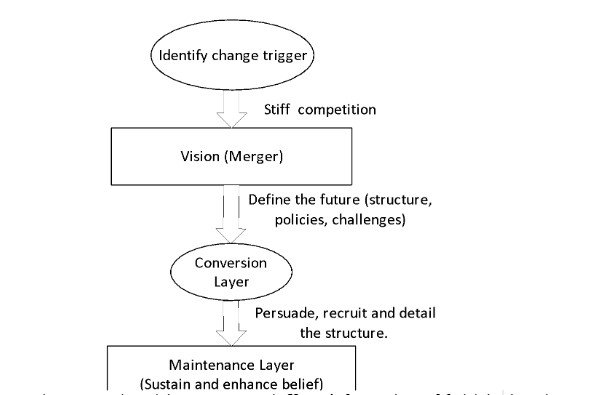
demonstrated an eight steps process in Kotter’s 8-step change Model that have in step-wise progressive means of adopting the changes in an organization. It is fundamentally important to adopt this steps to the point in order to avoid failure in future organization.
Kotter’s 8-step Model.
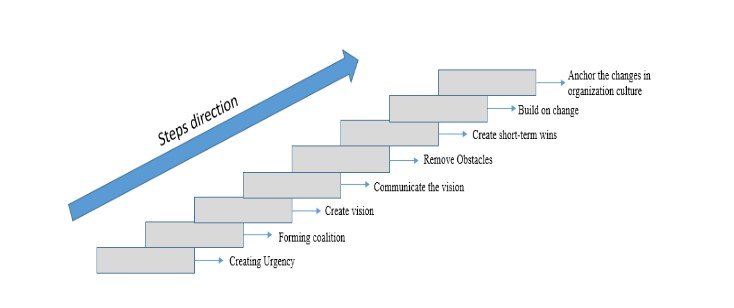
Diagram 3. Kotter change Model.

Step 1: Create Urgency.
For a real change to happen that will result in successful business takeover, a sense of urgency needs to be developed around the change to be implement, that is changing from management and promotions to corporate reputation management via internet (Kotter, 1979). This is a form of sparking the initial motivation to get things going and ‘buying into’ the change. This is achieved by opening an honest discussion and involvement with employees about the change, it is not a matter of showing employees and shareholders a mere statistics or talking about the change in the industry but what happening in the marketplace and competitors. Identify potential threats to be expected, creating scenarios examining opportunities to be exploited and forging support for outside stakeholders, customers and employees is a paramount in embracing change (Burnes, 2009). This step should be taken with caution, proper preparation and not to be rushed or panic.
Step 2: Form a powerful coalition.
All member of the organization regardless of status and post need to be fully on board of the changes expected. The leaders need to leader the change rather than manage it. For effective implementation of change, strong team, influential people and collision from different field of expertise, job title and political in the institution has to brought together (Greiner, 1972). This is done by identifying the true leaders in organization and also in key stakeholders and asking for

commitment for them. The teams has to be check for weakness and ensuring a mix of people before change.
Step 3: Create a vision and strategy of change.
A clear vision that people can easily gasp and follow is needed. When individuals see what is required of them, directives given to them tend to be simple and more sensible (Phelps, 2007). State explicitly the reason for the change and its benefits, and the future of the company, a good vision demands sacrifice for betterment of the organization shareholders. A strategy of transition must be there, such question as; the position of the organization at the moment, what it needs or rather future plans and how it will reach there, also the required knowledge, skills resources are fundamentally important at this stage
Step 4: Communicate the vision.
The vision of the organization to adopt the changing market for the business has to be communicated effectively, frequently and timely to all involved parties (Hayes, 2002). This can be through writing, reporting, motivation, meetings, training or direct engagement with employees, management and shareholders. The organization need to demonstrate the kind of attitude and embrace towards to changes, “walking the talk” instead of just say (Burnes, 2004). Also all the concerns from the parties involved should be addressed honestly and openly.

Step 5: Remove Obstacles.
People do not adopt change easily, some will resist, reluctant or have negativity. Continuously checking and removing barriers that gets in the way, and develop structures that eliminates them is necessary (Beer and Nohria, 2000). A team or leaders to oversee the transition can be hired with main role is to deliver the change, recognize the people for the abilities and efforts in enabling the smooth transition (Paton and McCalman, 2008). Assure the reorganization plans of the company and employee such as providing assurance of the job security, empowering and coaching the right individuals, also identifying and helping individuals who are against the change is necessary at this stage.
Step 6: Create short-term wins.
Creating a taste of success is a great motivating factor. A short combined sale by the ‘new company’ can demonstrate the end results after the change, this will silences the negative thinkers and critics (Schwartz and Shulman, 2007). Generally boosting morale among the employees and other stakeholders. This can be a week or two demonstration, it should be justifiable and thoroughly analyzed and thought through as failure can really hurt the project entirely (Burnes, 2009).
Step 7: Build on the change.

Professing success too early can lead to ultimate fall of the new company (Kotter, 1979). Real and long lasting change runs deep and have full understanding of the system. During

8: Institutionalize change.
Finally, for the change to be permanent, it should be part of the new organization core principles. Make continuous efforts to ensure the change is supported and seen by all the employees and stakeholders, and integrating gradually into organization culture (Smith, 2003). The structure and policies should be easy available and accessible for instance having new changes on the posters and company leaflets, moreover ensuring they are in marketing and advertising and company brochures. Organization culture determines what and how somethings are done, so the values behind the company vision must be displayed in day-to-day activities.
Implementation strategy
Transition.
Organizations have to plan for, divert resources to and thrive to implement, sustain, build and address the issues associated with the change required over time (Paton and McCalman, 2008). The development and recognition of existence of this Layers of change goes a long way in determining the management action needed.

Diagram 4. Factor and layer for change
In terms of the trigger layer, the stiff competition, need to be expressed in understandably clear and communicated throughout the organization (Paton & McCalman, 2008). After the trigger has been recognized and clearly expressed, the organization need to define its future.
CONCLUSION.
Change is progressive and imminent, be forced by circumstances to change and conform to the new order needs determination, courage, boldness and commitment for success from organization leaders and its stakeholders (employees, customers and key partners). In this case, Spotlight PR Ltd in its quest to remain in business has to conform to the changing business environment; the change of operation, policies, structure and leadership is required. For reorganization to be effective and successful, commitment from all parties is paramount and demonstrate by leaders in fostering the new outlook prior and after change respectively.

Beer, M. and Nohria, N. (2000). Cracking the Code of Change, Harvard Business Review, May-June, pp.133–141.
Bryson, J. (2008). Dominant, emergent and residual culture: The dynamics of organisation change. Journal of Organisational Change Management, 21(6), pp.743-757.
Burnes, B (2009). Managing Change: a Strategic Approach to Organisational Dynamics, 5th edition, Harlow: Financial Times/Prentice Hall:
Burnes, B. (2004). Emergent change or planned change- Competitors or allies? International Journal of Operations and Production Management, 24(9), pp.886–902. Dunphy, D. and Stace, D. (1993). The Strategic Management of Corporate Change. Human Relations, 46(8), pp.905-920.
Greiner, L. E. (1972). Evolution and Revolution as organisations grow, Harvard Business Review, 50, July-August, pp.37-46.
Hayes, J. (2002). The Theory and Practice of Change Management. 1st ed. Houndmills: Palgrave Macmillan, pp.2-200.
Hope, O. (2010). The Politics of Middle Management: Sensemaking and Sensegiving. Journal of Change Management, 10(2), pp.195-215.

Kotter, J. P. and Schesinger, L. A. (1979). Choosing Strategies for Change. Harvard Business Review, March–April, pp.106-114.
Mavondo, F. and Farrell, M. (2003). Cultural orientation, its relationship with market orientation, innovation and organisational performance. Management Decision, 41 (3), pp.241-249. McGreevy, M. (2003). The changing nature of work, Industrial and Commercial Training, 35(5), pp.191-195.
McGreevy, M. (2003). The changing nature of work. Industrial and Commercial Training, 35(5), pp.191-195.
Myers, P, Hulk, S, and Wiggins, L (2012). Organisational Change, Oxford: Oxford University Press.
Paton, R. and McCalman, J. (2008). Change Management: A Guide to Effective Implementation. 1st ed. London: SAGE Publications Ltd, pp.2-420.
Phelps, R., Adams, R. and Bessant, J. (2007). Life Cycles of Growing Organisations: A review with implications for knowledge and learning. International Journal of Management Reviews, 9(1), pp.1-30.
Schwarz, G.M. and Shulman, A.D. (2007). The Patterning of Limited Structural Change. Journal of Organisational Change Management, 20(6), pp.827–846.
Senior, B and Swailes, S (2010). Organisational Change, 4th Edition, Harlow: Prentice Hall Shook, J. (2010). How to change a culture: Lessons from NUMMI. MIT Sloan Management Review, 51(2), pp.62-68.
Smith, M. (2003). Changing and organisations culture: Correlates of success and failure. Leadership and Organisational Development Journal, 24(5), pp.249-260.
Van de Ven, A. and Kanhyong, S. (2011). Breakdowns in Implementing Models of Organisational Change. Academy of Management Perspectives, 25(3), pp.58- 73.

APPENDIX.
At any undefined situation, an action can be acted upon depending upon its parameters (Dunphy and Stace, 1993), as illustrate by matrix below.
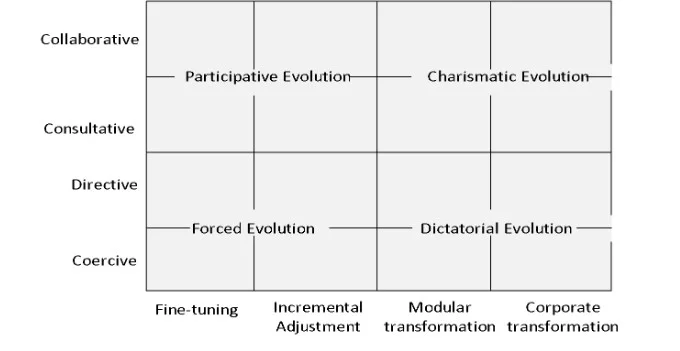
Diagram 3. Style of change, Dunphy and Stace change matrix. (Dunphy and Stace, 1993)
Take a deeper dive into A Personal Statement For In Banking And Finance with our additional resources.
- 24/7 Customer Support
- 100% Customer Satisfaction
- No Privacy Violation
- Quick Services
- Subject Experts



